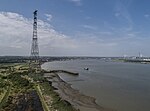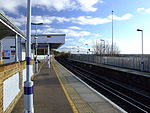Swanscombe railway station
DfT Category E stationsFormer South Eastern Railway (UK) stationsFormer Southern Railway (UK) stationsKent railway station stubsPages with no open date in Infobox station ... and 8 more
Railway stations in Great Britain closed in 1930Railway stations in Great Britain opened in 1908Railway stations in Great Britain opened in 1930Railway stations in KentRailway stations served by Govia Thameslink RailwayRailway stations served by SoutheasternTransport in the Borough of DartfordUse British English from August 2015

Swanscombe railway station is a railway station that serves the village of Swanscombe in north Kent, England. It is 21 miles 14 chains (34.1 km) down the line from London Charing Cross.
Excerpt from the Wikipedia article Swanscombe railway station (License: CC BY-SA 3.0, Authors, Images).Swanscombe railway station
All Saints Close,
Geographical coordinates (GPS) Address Nearby Places Show on map
Geographical coordinates (GPS)
| Latitude | Longitude |
|---|---|
| N 51.44912 ° | E 0.309867 ° |
Address
Swanscombe
All Saints Close
DA10 0LG , Swanscombe and Greenhithe
England, United Kingdom
Open on Google Maps






